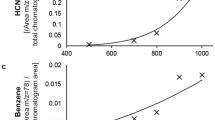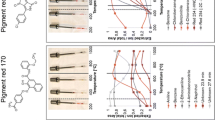Abstract
Since tattoos became overwhelmingly fashionable worldwide, the demand for removal has proportionally increased, Nd:YAG Q-switch laser being the most commonly used tool for the purpose. In this framework we investigated the composition and products of laser treatment of green tattoo ink, the Green Concentrate from Eternal. The ink characterization has been carried out by IR, UV–Vis, EDX spectroscopies, and SEM imaging. It revealed the presence of the pigment PG7, rather than PG36 as reported on the bottle label, along with non-fully halogenated analogues. The morphology is an extended sheath with embedded grains. Subsequent laser treatments were performed on both dried and extracted inks, dispersed either in water or in propan-2-ol, chosen for their different polarities, as it is the case in the skin layers. The products were analyzed by gas chromatography-mass spectrometry, UV–Vis spectroscopy, SEM imaging, and dynamic light scattering. The outcome is a complex fragmentation pattern that depends both on the solvent and on the initial aggregation state. The fragment compounds are toxic at various degrees according to the Classification Labelling and Packaging regulations. Several shapes of aggregates are produced as an effect of both downsizing and re-aggregation, with potentially harmful aspect ratios.






Similar content being viewed by others
References
Achar BN, Mohan Kumar TM, Lokesh KS (2007) Synthesis, characterization, pyrolysis kinetics and conductivity studies of chloro substituted cobalt phthalocyanines. J Coord Chem 60:1833–1846
Anderson R, Parrish J (1983) Selective photothermolysis: precise microsurgery by selective absorption of pulsed radiation. Science 220:524–527
Ara G, Anderson R, Mandel K, Ottesen M, Oseroff AR (1990) Irradiation of pigmented melanoma cells with high intensity pulsed radiation generates acoustic waves and kills cells. Lasers Surg Med 10:52–59
Barret PA, Bradrook EF, Dent CE, Linstead RP (1939) Phthalocyanines and related compounds. Part XVI. The halogenation of phthalocyanines. J Chem Soc 1820–1828
Barszcz B, Bogucki A, Biadasz A, Bursa B, Wróbel D, Graja A (2011) Molecular orientation and spectral investigations of Langmuir–Blodgett films of selected copper phthalocyanines. J Photochem Photobiol A 218:48–57
Bauer EM, De Caro T, Tagliatesta P, Carbone M, (2019) Unraveling the real pigment composition of tattoo inks: the case of bi-components phthalocyanine based greens. Dyes Pigm 167:225–235
Berne BJ, Pecora R (2000) Dynamic light scattering: with applications to chemistry, biology, and physics. Courier Corporation, North Chelmsford
Bernstein EF (2017) Laser tattoo removal. Semin Plast Surg 21:175–192
Bocca B, Sabbioni E, Miceti I, Alimonti A, Petruccia F (2017) Size and metal composition characterization of nano- and microparticles in tattoo inks by a combination of analytical techniques. J Anal Atom Spectrom 3:2616–2628
Boulanger G, Andujar P, Pairon J-C, Billon-Galland M-A, Dion C, Dumortier P, Brochard P, Sobaszek A, Bartsch P, Paris C, Jaurand M-C (2014) Quantification of short and long asbestos fibers to assess asbestos exposure: a review of fiber size toxicity. Environ Health 13:59
Bucella M, Dorigato A, Rizzola F, Caldara M, Fambri L (2018) Influence of the processing parameters on the dispersion and coloration behavior of a halogenated copper phthalocyanine-based masterbatch. Adv Polym Tech 37:21721
CHEM SPACE. https://chem-space.com/
Classification, labelling and packaging regulation (CLP) at ECHA https://web.archive.org/web/20090309042730/http://echa.europa.eu/classification/clp_regulation_en.asp
Code of Federal Regulations (2015) Office of the Federal Register; Title 21, Section 703 (f) and 705(b) US Government Printing Office: Washington, DC, 2015
Compiled RAC and SEAC Opinion on an Annex XV dossier proposing restrictions on substances used in tattoo inks and permanent make-up ECHA/RAC/RES-O-0000001412-86-240/F, ECHA/SEAC/ECHA/SEAC/RES-O-0000001412-86-265/F, https://echa.europa.eu/it/registry-of-restriction-intentions/-/dislist/details/0b0236e180dff62a. Accessed April 24th 2020
ECHA substance Infocard. https://echa.europa.eu/substance-information/-/substanceinfo/100.014.125
Everts S (2016) Chemical and Engineering News, American Chemical Society, August 22nd, 2016 FDA cosmetic facts: tattoos and permanent makeup
Gaudron S, Ferrier-Le Bouëdec MC, Franck F, D’Incan M (2014) Azopigments and quinacridones induce delayed hypersensitivity in red tattoos. Contact Dermatitis 72:97–105
Germinario G, van der Werf ID, Sabbatini L (2015) Pyrolysis gas chromatography mass spectrometry of two green phthalocyanine pigments and their identification in paint systems. J Anal Appl Pyrolysis 115:175–183
Giumanini AG, Verardo G, Strazzolini P (1989) The photolysis of 2,4,5,6-tetrachloro-1,3-dicyanobenzene. J Photochem Photobiol A 48:129–153
Golka K, Kopps S, Myslak ZW (2004) Carcinogenicity of azo colorants: influence of solubility and bioavailability. Toxicol Lett 151:203–210
Hauri U (2014) Inks for tattoos and permanent make-up—pigments, preservatives, aromatic amines, polyaromatic hydrocarbons and nitrosamines Swiss National Investigation Campaign 2014 Department of Health, Kanton Basel-Stadt http://www.kantonslaborbsch/dms/kantonslabor/download/berichte/berichte-2014/Tattoo_PMU_2014_EN-UK-/Tattoo_PMU_2014_EN%28UK%29pdf
Hauri U, Hohl C (2015) Photostability and breakdown products of pigments currently used in tattoo inks. Curr Probl Dermatol 48:164–169
Herbst W, Hunger K (2004) Industrial organic pigments, 3rd edn. WILEY-VCH Verlag GmbH & Co, Weinheim
Hering H, Sung AY, Röder N, Hutzler Ch, Berlien HP, Laux P, Luch A, Schreiver I (2018) Laser irradiation of organic tattoo pigments releases carcinogens with 3,3′-dichlorobenzidine inducing DNA strand breaks in human skin cells. J Invest Dermatol 13:2687–2690
Ho SG, Goh CL (2015) Laser tattoo removal: a clinical update. J Cutan Aesthet Surg 8:9–15
Høgsberg T, Loeschner K, Löf D, Serup J (2011) Tattoo inks in general usage contain nanoparticles. Br J Dermatol 165:1210–1218
Kaur RR, Kirby W, Maibach H (2009) Cutaneous allergic reactions to tattoo ink. J Cosmet Dermatol 8:295–300
Kihara R, Imada S, Kawai T, Asahi T (2019) Fabrication of nanorods colloids of copper hexadecafluorophthalocyanine by nanosecond-pulse laser fragmentation in organic solvents. Appl Surf Sci 478:532–538
Klitzman B (2013) Development of permanent but removable tattoos German Federal Institute for Risk Assessment (BfR) conference on tattoo safety; Berlin, Germany; June 6–7, 2013 http://www.bfr.bund.de/cm/343/development-of-permanent-but-removable-tattoos.pdf. Accessed Apr 10 2019.
Kluger N, Koljonen V (2012) Tattoos, inks, and cancer. Lancet Oncol 13:e161–e168
Koppel DE (1972) Analysis of macromolecular polydispersity in intensity correlation spectroscopy: the method of cumulants. J Chem Phys 57:4814–4820
LaBrosse JL, Anderegg RJ (1984) The mass spectrometer as a chlorine-selective chromatographic detector. J Chromatogr A 3:1483–1492
Laumann A, Derick A (2006) Tattoos and body piercings in the United States: a national data set. J Am Acad Dermatol 55:413–421
Laux P, Tralau T, Tentschert J, Blume A, Al Dahouk S, Bäumler W, Bernstein E, Bocca B, Alimonti A, Coleman H, de Cuyper C, Coleb H, Dähne L, Hauri U, Howard PC, Janssen P, Katz L, Klitzman B, Kluger N, Krutak L, Platzek T, Scott-Lang V, Serup J, Teubner W, Schriver I, Wilkniß E, Luch A (2016) A medical-toxicological view of tattooing. Lancet 387:395–402
Lawson CL, Hanson RJ (1974) Solving least squares problems. Prentice Hall, Englewood Cliffs
Lu F, Wang C, Zhao R, Du L, Fang Z, Guo X, Zhao Z (2018) Review of stratum corneum impedance measurement in non-invasive penetration application. Biosensors 8:31
Ma Y, Guo Y, Wu S, Lv Z, Zhang Q, Ke Y (2017) Titanium dioxide nanoparticles induce size-dependent cytotoxicity and genomic DNA hypomethylation in human respiratory cells. RCS Adv 7:23560–23572
Meng F, Liu X (2014) Growing nano-petals on electrospun micro/nano fibers. RCS Adv 4:8699–8702
Mohanta D, Patnaik S, Sood S, Das N (2019) Carbon nanotubes: evaluation of toxicity at biointerfaces. J Pharm Anal 9:293–300
Muroyama A, Lechler T (2012) Polarity and stratification of the epidermis. Semin Cell Dev Biol 23:890–896
Murphy MJ (2018) High speed ink aggregates are ejected from tattoos during Q-switched Nd:YAG laser treatments. Lasers Surg Med 50:711–717
Pan Z, Lee W, Slutsky L, Clark RAF, Pernodet N, Rafailovich MH (2009) Adverse effects of titanium dioxide nanoparticles on human dermal fibroblasts and how to protect cells. Small 5:511–520
Pothiawala S, Kilmer SL, Ibrahimi OA (2014) Laser tattoo removal. In: Keyvan N (ed) Handbook of lasers in dermatology. Springer, Berlin
Regulations in single European countries: France—Arrêté du 6 mars 2013 fixant la liste des substances qui ne peuvent pas entrer dans la composition des produits de tatouage, https://www.legifrance.gouv.fr/eli/arrete/2013/3/6/AFSP1306308A/jo/texte
Regulations in single European countries: Spain—Informaciόn sobre productos para maquillaje permanente (micropigmentaciόn) y tatuaje. https://www.aemps.gob.es/informa/notasInformativas/cosmeticosHigiene/2008/NI-prodAutorizados-tatuaje_julio-2008.htm
Regulations in single European countries: Sweden—Förordning (2012:503) om tatueringsfärger. https://www.riksdagen.se/sv/dokument-lagar/dokument/svensk-forfattningssamling/forordning-2012503-omtatueringsfarger_sfs-2012-503
Regulations in single European countries: The Netherlands—Besluit van 24 April 2013, houdende wijziging van he Warenwetbesluit tatoeagekleurstoffen in verband met het intrekken van Richtlijn 76/768/EEG. https://zoek.officielebekendmakingen.nl/stb-2013-177.html
ResAP (2003) 2 Resolution on tattoos and permanent make-up. https://search.coe.int/cm/Pages/result_details.aspx?ObjectID=09000016805df8e5. Accessed Apr 24 2020
ResAP (2008) 1 Council of Europe Resolution on requirements and criteria for the safety of tattoos and permanent make-up Feb 20th 2008. https://search.coe.int/cm/Pages/result_details.aspx?ObjectID=09000016805d3dc4. Accessed Apr 24 2020
Safety Assessment WHO 2002 World Health Organization (WHO) (2002) Folium et Cortex Hamamelidis in “WHO monographs on selected medicinal plants”, Geneva: 2:124–136. https://apps.who.int/iris/bitstream/handle/10665/42052/9241545372.pdf?sequence=2&isAllowed=y
Safety Assessment (2017) of Hamamelis virginiana (Witch Hazel)-derived ingredients as used in cosmetics. https://www.cir-safety.org/sites/default/files/Witch%20Hazel.pdf
Schreiver I, Hutzler C, Laux P, Berlien H-P, Luch A (2015) Formation of highly toxic hydrogen cyanide upon ruby laser irradiation of the tattoo pigment phthalocyanine blue. Sci Rep 5:12915
Schreiver I, Hutzler C, Andree S, Laux P, Luch A (2016) Identification and hazard prediction of tattoo pigments by means of pyrolysis-gas chromatography/mass spectrometry. Arch Toxicol 90:1639–1650
Schröder K, Pohlenz-Michel C, Simetska N, Voss J-U, Escher S, Mangelsdorf I (2014) Carcinogenicity and Mutagenicity of Nanoparticles—Assessment of Current Knowledge as Basis for Regulation Fraunhofer Institute for Toxicology and Experimental Medicine, Hannover, On behalf of the Federal Environment Agency (Germany) 50/2014. https://www.umweltbundesamt.de/sites/default/files/medien/378/publikationen/texte_50_2014_carcinogenicity_and_mutagenicity_of_nanoparticles_1.pdf
Statistics. https://www.advdermatology.com/blog/statistics-surrounding-tattoo-regret
Steinbach F, Schmidt HH (1975) Metal phthalocyanines used as catalysts in gas phase reactions IV. Oxidation of 2-propanol catalyzed by monomeric beta-Cu-phthalocyanne in the presence of sulfur compounds. J Catal 39:190–197
Swiss Regulation (2005) Das Eidgenössische Departement des Innern (EDI) Verordnung über Gegenstände für den Schleimhaut-, Haut- und Haarkontakt sowie über Kerzen, Streichhölzer, Feuerzeuge und Scherzartikel (Verordnung über Gegenstände für den Humankontakt) Bern: Swiss Government, 2005: 1–26, https://www.admin.ch/opc/de/classified-compilation/20050181/index.html. Accessed April 24th 2020
TätoV (2008)—Tätowiermittel-Verordnung Nov 13, 2008, BGBl I S 2215, last amended January 26th, 2016, BGBl I S 108. https://www.gesetze-im-internet.de/t_tov/BJNR221500008.html. Accessed Apr 24 2020
Taylor C, Anderson R, Gange R, Michaud N, Flotte TJ (1991) Light and electron microscopic analysis of tattoos treated by Q-switched ruby laser. J Invest Dermatol 97:131–136
Trouiller B, Reliene R, Westbrook Solaimani AP, Schiestl RH (2009) Titanium dioxide nanoparticles induce DNA damage and genetic instability in vivo in mice. Cancer Res 69:8784–8789
TSCA Inventory March (2020) https://www.epagov/tsca-inventory
Varga Z, Nicol E, Bouchonnet S (2020) Photodegradation of benziosothiazolinone: identification and biological activity of degradation products. Chemosphere 240:124862
Vasold R, Naarmann N, Ulrich H, Fischer D, Konig B, Landthale M, Bäumler W (2004) Tattoo pigments are cleaved by laser light-the chemical analysis in vitro provide evidence for hazardous compounds. Photochem Photobiol 80:185–190
Venugopala Reddy KR, Keshavayya J (2002) Synthesis of symmetrically substituted octabromophthalocyanine pigments and their characterization. Dyes Pigm 53:187–194
Vicum L, Mazzotti M, Iggland M (2019) Precipitation and crystallization of pigments. In: Myerson AS, Lee AY (eds) Handbook of industrial crystallization. Cambridge University Press, Deniz Erdemir
Wang H, Mauthoor S, Din S, Gardener JA, Chang R, Warner M, Aeppli G, McComb DW, Ryan MP, Wu W, Fisher AJ, Stoneham M, Heutz S (2010) Ultralong copper phthalocyanine nanowires with new crystal structure and broad optical absorption. ACS Nano 4:3921–3926
Wang Z, Yang W, Wei J, Meng F, Liu X (2014) Preparation and microwave absorption properties of rod-like iron phthalocyanine with nitrile and nitro groups. Mater Lett 123:6–9
Wenig P, Odermatt J (2010) OpenChrom: a cross-platform open source software for the mass spectrometric analysis of chromatographic data. BMC Bioinform 11:405. http://www.openchrom.net
Author information
Authors and Affiliations
Corresponding author
Ethics declarations
Conflict of interest
The authors declare that they have no conflict of interest.
Additional information
Publisher's Note
Springer Nature remains neutral with regard to jurisdictional claims in published maps and institutional affiliations.
Electronic supplementary material
Below is the link to the electronic supplementary material.
Rights and permissions
About this article
Cite this article
Bauer, E.M., Scibetta, E.V., Cecchetti, D. et al. Treatments of a phthalocyanine-based green ink for tattoo removal purposes: generation of toxic fragments and potentially harmful morphologies. Arch Toxicol 94, 2359–2375 (2020). https://doi.org/10.1007/s00204-020-02790-7
Received:
Accepted:
Published:
Issue Date:
DOI: https://doi.org/10.1007/s00204-020-02790-7




